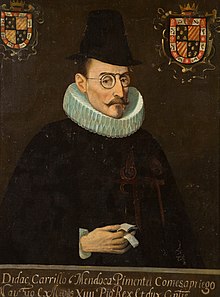Diego Carrillo de Mendoza y Pimentel
Diego Carrillo de Mendoza y Pimentel , Marqués de Gélves y Conde de Priego (* before 1590 in Valladolid , Aragón , Spain , † 1631 in Madrid , Spain) was a Spanish colonial administrator who officiated as Viceroy of Aragon and New Spain.
Origin and career in Europe
Diego Carrillo de Mendoza came from a noble family and entered the army service of the Spanish crown at a young age, where he quickly made a career.
In 1610 he was appointed by King Philip III. as viceroy in the Kingdom of Aragón , which has been ruled by viceroys of the Spanish crown since 1485.
He held office until 1621, when he was named Viceroy of New Spain by the new King Philip IV .
Tenure as Viceroy of New Spain
Carrillo de Mendoza reached the port of Veracruz on September 21, 1621 and from that day assumed responsibility for the Viceroyalty, as his predecessor Diego Fernández de Córdoba was already on the way to his next post in Peru . The official inauguration took place on April 8, 1622 in Mexico City .
The new viceroyalty found the country in a rather desolate state; After a bad harvest, the poor in particular faced famine. Carrillo had 10,000 bushels of corn bought and given to the poor. He turned against the monopoly of the grain merchants, which drove up prices, and thus made powerful enemies.
He also intervened against the widespread mugging of muggers by having armed men guard the main routes and rigorously executing any muggers that were caught.
At his suggestion, the local doctor Cristóbal Hidalgo y Bandaval gave lectures in surgery at the Universidad de México .
For cost reasons, he ordered the work on the Huehuetoca drainage system to be stopped and the dike that prevented the Río Cuautitlán from flowing into it was torn down . The next rainy season promptly led to severe floods, which left numerous dead and injured and caused considerable damage.
Conflict with the archbishop
Carrillo got into a serious conflict with the Archbishop of Mexico City, Juan Pérez de la Serna . The viceroy accused the bishop of bribery and condemned his trading activities.
When the viceroy accused a high official who had hoarded grain during times of hunger, he fled to a monastery. Carrillo had the monastery converted, but the archbishop insisted on the right of sanctuary and unceremoniously excommunicated the responsible judge and the executing officials. In his palace on January 11, 1624, the viceroy was in consultation with the Oidores of the Real Audiencia of Mexico to remove the bishop when he appeared in a sedan chair at the head of an angry crowd at the palace. Viceroy Carrillo called on him to withdraw the excommunication of the officials, whereupon the archbishop excommunicated the viceroy and the Oidores .
Carrillo ordered the archbishop to be captured and guarded and sent back to Spain. This arrest finally sparked riot. A mob stormed the viceroy's palace and set it on fire. The archbishop managed to escape and he declared the viceroy deposed. He had secretly fled from the indignant crowd with some faithful to the San Francisco Church . From there he got to Veracruz and embarked back to Spain to justify himself to King Philip IV. The king passed mixed judgment, approving some of Carrillo's actions and disapproving others.
Archbishop Pérez de la Serna initially remained in office in Mexico; but after the arrival of the next viceroy he was ordered back to Europe, where he received the diocese of Zamora .
Carrillo died in Spain in 1631.
swell
- Short biography (Spanish)
- Biography (spanish)
| predecessor | Office | successor |
|---|---|---|
| Diego Fernández de Cordoba |
Viceroy of New Spain (Mexico) 1621–1624 |
Rodrigo Pacheco y Osorio |
| personal data | |
|---|---|
| SURNAME | Carrillo de Mendoza y Pimentel, Diego |
| ALTERNATIVE NAMES | Marqués de Gélves, Conde de Priego, Count of Priego |
| BRIEF DESCRIPTION | Spanish colonial administrator |
| DATE OF BIRTH | before 1590 |
| PLACE OF BIRTH | Valladolid , Aragon , Spain |
| DATE OF DEATH | 1631 |
| Place of death | Madrid , Spain |
